Date:
April 17th, 2007
Length of Cruise:
17 Days
Ship:
Sun Princess
Cruise Line (Princess #): Princess Cruise Lines (#5)
Embarkation:
Ft. Lauderdale, FL
Ports of Call:
Aruba, Panama Canal, Panama City,
Puerto Amador, Costa Rica, Puntarenas,
Hualulco, Acapulco, Cabo San Lucas,
San Diego
Final Destination:
Seattle, W
Total Days With Princess: 45
Total Days At Sea: 52 |
| This cruise is actually more than just
a cruise. It was a trip to Florida, then a 17-day cruise to
Seattle via Panama Canal, then a drive across Washington to
Valley, WA (just north of Spokane, WA), then down to Pasco, WA
and back down to Pleasanton. To make the file easier to use, I
will split it up into three sections: Through The Canal, After
The Canal, and After The Cruise. Click on any of the three
selections below and it will take you to the section you desire. |
| TECH: For those that are interested,
TECHNICAL data will be placed in a box such as this, and you may
wish to not be concerned with it. If you do choose to skip the
reading of these boxes, you will not miss any part of the story.
|
| Preliminaries: We caught the "red-eye" from
Oakland California at 0045 hours, changed planes in Houston, Texas
with less than an hour lay-over, and arrived in Ft. Lauderdale, FL
around 1030 hours. We caught a taxi after we found our luggage and
traveled half a dozen miles to Pier 66, a rather middle-upper class
hotel with a nice pool and several food and drinking establishments,
including the one near the pool. We had a nice room in the back,
right on an estuary that was a passage way and berthing location for
very nice yachts. The Tri-maran just outside our balcony was at
least 45 feet long and it had a mast that would easily reach 60 feet
in height. It was For Sale at a cool $850,000. There were larger ones if they would better fit your taste. A dealer was next door. Lots
of white fiberglass. |
|
First Day: 19 April, 2007
Location: Ft. Lauderdale, Florida
We packed up and left the hotel on Pier 66 in Ft. Lauderdale,
Florida, at 1205 hours, had the hotel snag us a taxi, and zipped
over the back-bay to the dock where our Sun Princess was waiting for
us (and 1948 other passengers). We have walked that distance in the
past, but did not try it with four rolling suitcases packed for a
month (we were including a week in cool-ish Seattle and Washington
State at the end of this cruise). 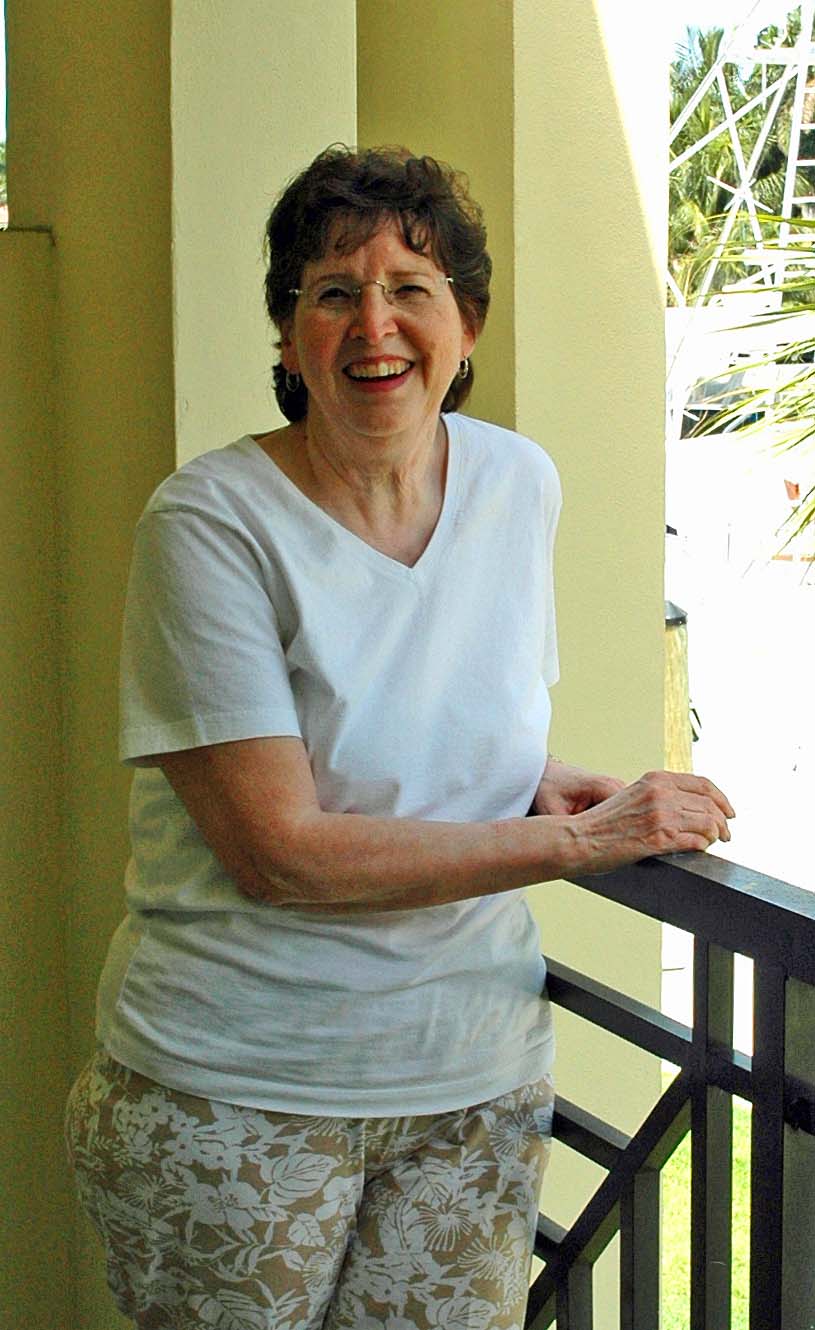
This is
the seventh cruise that my wife, Rosalee and I have taken, the fifth
on a Princess ship. I have to tell you that it was a cruise with
many “firsts” for us. When we arrived at the dock, our bags were
given to the man with the cap and we walked into the port building
looking for the long lines we expected (and have experienced here
before). We never saw any. Within 25 minutes we went from the hotel
room to being on board, with our pictures having been taken by the
photographers for the ship-board computers (as we walked on board).
That is the fastest it has ever happened to us on any cruise. I love
that computer check-in (as well as the wonderful assistance of our
travel agent, Suzy Cruisy ). That was the nicest “first” that we
have ever experienced.
We went
straight-away to our cabin: Three Forty-Five on Aloha Deck,
starboard side (that would be RIGHT side for the grounded folks
reading this. FYI: the PORT side is the LEFT side, and they both
have four letters in them… PORT… LEFT…). A345 is a double-occupancy
cabin with a comfortable exterior balcony. On the Princess internet
site you can take “virtual tours” of the cabins and public areas,
but basically, as you walk into the cabin, there is an adequate
toilet / shower / vanity room to one side and plenty of storage on
the other. Beyond that was a nice double bed with room to walk on
all three sides. A desk with six drawers was next to the sliding
glass door (porthole?) that made up the whole outside bulkhead
(wall), with another bulkhead four feet out from the sliding door,
to make way for a very comfortable cabin-width exterior balcony. A
bookshelf / cabinet with a small refrigerator inside and a 16” TV on
the top were on the other side of the cabin. Two comfortable fabric
outdoor chairs and a small table were on the very private balcony
(private except when in port, berthed next to another ship). The
image is of Rosalee on the balcony of the motel room in St.
Lauderdale.
The Sun
Princess is a venerable ship that has been in the water for nearly a
decade. That may seem like a long time in the World of Cruise Ships,
where each new ship is competing for the cruising dollars, but she
looked fit and trim and did not show her age during the entire
cruise. We have twice cruised on her sister-ship, Dawn, so we felt
“right at home” on board. There are three general areas on the ship
where a set of ladders or companionway (stairs) and lifts
(elevators) are grouped together: one forward, one amidships, and
one aft. One of the amidships set of ladders and lifts only go from
Plaza (5) deck through Dolphin (8) (they are the ornate ones
(circular staircases and glass elevators) that are in the Atrium
area). The aft set services decks Promenade (7) to Lido (14). The
forward set runs all the way, from Fiesta (4) to Lido (14) - ten
full decks (no deck 13 on any ships – Olde Sea Lore, you know).
There is a Sun (15) deck, for those that are looking for some direct
sun, and the decks below Fiesta (4) are generally not open to
passengers. One thing my wife and I have always done on our cruises
is walk. With all the great food aboard (that cannot be passed up),
it has to be burned off somewhere… so we walk some more. It is our
belief that if we cannot force ourselves to climb the ladders
(stairs), we should not be allowed to eat. It will be tough if one
of us ever gets to where we cannot physically climb them, but (of
course) the lifts are there for that reason. We will just have to
cut out a couple of meals a day when that happens.
The
Promenade (7) Deck is where the two main theatres, the Photo
Gallery, the Internet Café, Library, Art Gallery, Shooting Stars
Disco, Wheelhouse Bar, Rendezvous Bar, and the Atrium Lounge are
located. The name likely comes from the fact that it is one of the
only decks that you can walk completely around (promenade means walk
or parade, right?) without having to go step inside anytime during
the stroll around the ship. Three times around will make up a
complete mile, so you can “keep in shape” if you enjoy walking. It
is also where you would board the life boats (launches) that are
stored just overhead. They are small, enclosed motor craft that
carry several hundred people each. Encapsulated rubber rafts are
also nearby. I think that they learned a good lesson on Titanic
(yes, I DID count the number of passengers they could all carry… and
there really are enough life boats).
Our cabin
was just forward of the forward ladder and lift area. That is the
furthest forward that we have ever slept when we have sailed. We
were booked on another similar cruise, but it had to be canceled and
Suzy was only able to get us on this one in the last few months, so
our choice was limited. We are usually amidships, to miss the wave
action under the bow and the sensations of the rudder and screws
that are usually felt in the aft. As it turned out, we would not
hesitate to book in this area again. It was quite comfortable.
More
“firsts” for us: with seventeen days duration and the schedule
falling just after Easter vacations, this is not only the longest
duration cruise we have undertaken but the passenger list is heavily
weighted toward the “seasoned” crowd. We have heard a rumor that
there actually is one youngster on board. We have only seen less
then a handful of passengers that are younger than the “Medicare”
age.
Casting
Off is always an exciting time. Often referred to as "Sail Away" it
is interesting to see the activities in the various harbors that we
visit, and leaving the first one is a special treat in itself. If
you locate yourself forward in certain locations, you can see the
deck hands working the winches and lines and windlasses and chains
and capstans… all of that nautical stuff that determines if the ship
will be “held fast” to the dock in a shallow harbor, or if she will
be free to move. A “Pilot” boat is involved, to ferry the “harbor
pilot” back to shore after the ship clears the harbor. Most ports
insist on each ship paying for the services of a harbor pilot. They
know the rocks, channels, bridges, etc. better than most Captains.
One or two sheriff’s boats start herding domestic watercraft, the
BIG HORN blasts a time or two… and things start moving. Silt from
the bottom of the harbor starts churning up from the movement of the
side-thruster motors that move the ship sideways, and the sea gulls
go crazy with the cornucopia of sea life that comes up to the bottom
of the harbor. All of a sudden, you realize that this huge
“sky-scraper” that is lying on her side is moving and the rest of
the world is standing still. Two million pounds of steel is
underway. Bon Voyage!
Most
Cruise Ships today have 'side thrusters' at both the bow and the
stern. They are each actually a seven foot wide hole through the
hull with a large electric propeller standing in them and they can
turn either direction. That allows the ship to pull away or slowly
approach the dock, without using a tug boat. Tugs cost a lot of
money to hire. The thrusters also allow the ships to literally turn
a complete circle "on a dime" ...a pirouette.
Another
unusual event for our association with Princess is that one of our
four luggage pieces was delayed in getting to our cabin. You can
dine in a lot of places on this ship, but the two main dining rooms
(Regency and Marquis) do require long pants, and everything that we
have that goes below the knee is in the missing luggage piece.
Around dinnertime we checked with our room steward, Geraldo (who had
already stopped in to introduce himself), about the missing case and
he went on a search for us. He told us that there were some that
were being held at the Reception Desk in the Grand Plaza for any of
various reasons. We took a quick hike (to Plaza (5) deck) to the
Reception Desk and there it was. Someone, somewhere, had marked out
our cabin number. It would have found us, eventually, but we were
hungry.
We had
arranged to have the “Anytime” or “Personal Choice” dining which
means we can go to the Marquis Dining Room anytime after 1750 hours
(5:30 pm), and sit at any of various tables. We usually tell them
there are two of us and we will “sit with others”, which is what
they love to hear, because they can seat us to fill out a table or
start a new one. Either way, we have stimulation and enjoyable
conversation from meeting other diners. Since we were late this
night, they only had “tables for two”, which was fine. Prime Rib
(medium rare) and Rosalee… how can I ever go wrong with that
combination?
There are
usually two evening shows during the dining hours, to accommodate
those that eat early or those that eat late. We usually try to dine
as early as we can (1750 or 1800 hours), so we can catch two shows.
There are shows in both large public areas (the Princess Theater in
the bow and the Vista Lounge in the aft) as well as many other
musicians, comedians, karaoke artists, dancing, night clubs, teen
clubs, video arcades or what-have-you spread all over the ship. We
were late for the first show so we sat in the Atrium Lounge and
enjoyed a pianist that was witty and wonderful on the keys. Maybe it
is the seasoned passengers that prompted him but he was playing hits
from Porter, Lombardo, Goodman, Lerner & Lowe… all the “hits”. He
was wonderful. After he was through we made it to the Princess
Theater for the “Welcome Aboard - Showtime” where we were introduced
to the Sun Princess Dancers seen in many of the productions on board
over the next few weeks, as well as the large “visible” Cruise
Staff. They finished off with a talented comedian that has been seen
on HBO and Saturday Night Live. He had me in stitches.
After the
proverbial stop in the Grand Casino on Dolphin (8) Deck to make my
nightly deposit, we went up to A345 to find our bed nicely turned
down with little chocolate hearts on the pillow, just enough lights
turned on to find our way, curtains drawn, and the temperature just
right. I thought I would watch a movie on TV but I don’t remember
much of it. We slept well. |
|
Day
Two: 20 April, 2007 -- 1030 Hours
|
For the “techie
geeks” on board, our cabin TV has a channel with all
the pertinent information that you could ever want,
including the Captain’s shoe size. Part of this
information comes in a “Report From the Bridge” that
runs every 15 minutes, and it includes a map of the
entire intended cruise, then it “zooms in” to where
it shows the ship’s location just off Archipelago De
La Camagbey, Cayo Romano, Cayo Guajabga, Cayo
Sabinal, Puerto Menati and Chaparra… all locations
in Cuba. So, THAT’S what I see off in the distance.
Let’s all wave to Fidel. The map also shows that we
will cut in just past the south-eastern tip of Cuba,
just before Haiti and the Dominican Republic. |
Sun Princess is
now underway to Oranjestad, Aruba (about 750
nautical miles away, and we are currently over 300
nautical miles from Ft. Lauderdale), cruising at the
speed of 18.2 Knots (nautical miles per hour) --
Weather: Sunny -- Wind Direction Across the Deck:
North -- Outside Air Temperature:25.7°C -- Inside
Air Temperature: 73°F -- Sea Temperature: 26.7°C --
Current Weather: Sunny -- Air Pressure: 1013.2 mbar
(or 29.9 inches of mercury (hg))-- Barometer: Rising
-- Sea Condition: Smooth Wavelets (0.1 – 0.5 meters)
-- Wind Speed: Force 3 (Gentle Breeze) -- Ship’s
Position: N 21° 25’ W 67° 12’ -- Ship’s Heading:
113° (that would be south-east if that is confusing
to you). |
|
This TV channel
also runs a little segment on what the current time
is in six cities around the world, as well as the
current ship’s time, and GMT (Greenwich Mean Time --
the boss of all the clocks worldwide – eight hours
ahead of PDT). Another segment introduced you to the
many ranks of officers on the ship and shows the
insignia that they wear (just in the case that you
might need to find the Chief Executive Purser’s Mate
- Second Class). It also gives our Estimated Time of
Arrival at the next port, and the Estimated Time of
Departure from that port. You can “bank” on that
ETD… the ships don’t wait around for stragglers. |
We grabbed
breakfast in the Horizon Court on Lido (14) deck… a beautiful space
that is the full width of the ship, right up front, where you can
see everything in front of the ship… and all you can see is blue as
far as you can see. We are directly over the Bridge and have the
same view as the crew that hold the ship’s reins in their hands. At
856 feet long, 106 feet wide and a gross tonnage of 77,441, it is
indeed impressive to see how well she rides the waves. The Sun
Princess runs on crude diesel fuel that has to be heated before it
can be liquid enough to purify it and burn it in her four
sixteen-cylinder engines. They generate electricity for everything,
including the huge electric motors that spin the two screws that
push this vessel at 21 knots. Their water on-board comes right out
of the deep blue sea, but it is desalinated and filtered first,
right here on board. They could supply water and power to a small
city if they parked this boat on Main Street, USA.
Today is
an “at sea” day, and that means that it will be “Dress: Formal”
tonight in the main dining halls. This cruise is a 17-day duration,
so we will have a few “at-sea” days that will not be formal. We will
have three formal nights in total on this cruise. It seems a bit of
a bother to be prepared and bring the clothing to be formal, but
everyone in the dining halls just act so differently on “formal”
nights. It’s kind of like the kids at Sunday school I suppose. After
all, meeting the other people on board is one of the best parts
about having this many people contained on this floating island for
this long.
Any Formal
Night means that the ship’s photographers are out in force. They set
up their cameras and lights at all the locations in the Grand Plaza:
On the Grand Staircase… near several of the two dozen grand pianos
on board… near the glass elevators… all of the “Grand” images that
will look good in your albums at home. We got our pictures taken,
but the wait did delay our trip to the Marquis Dinning Room. There
was a 20-minute waiting line to take us in to dinner, which we never
have endured before, so we will be sure not to make that mistake
again.
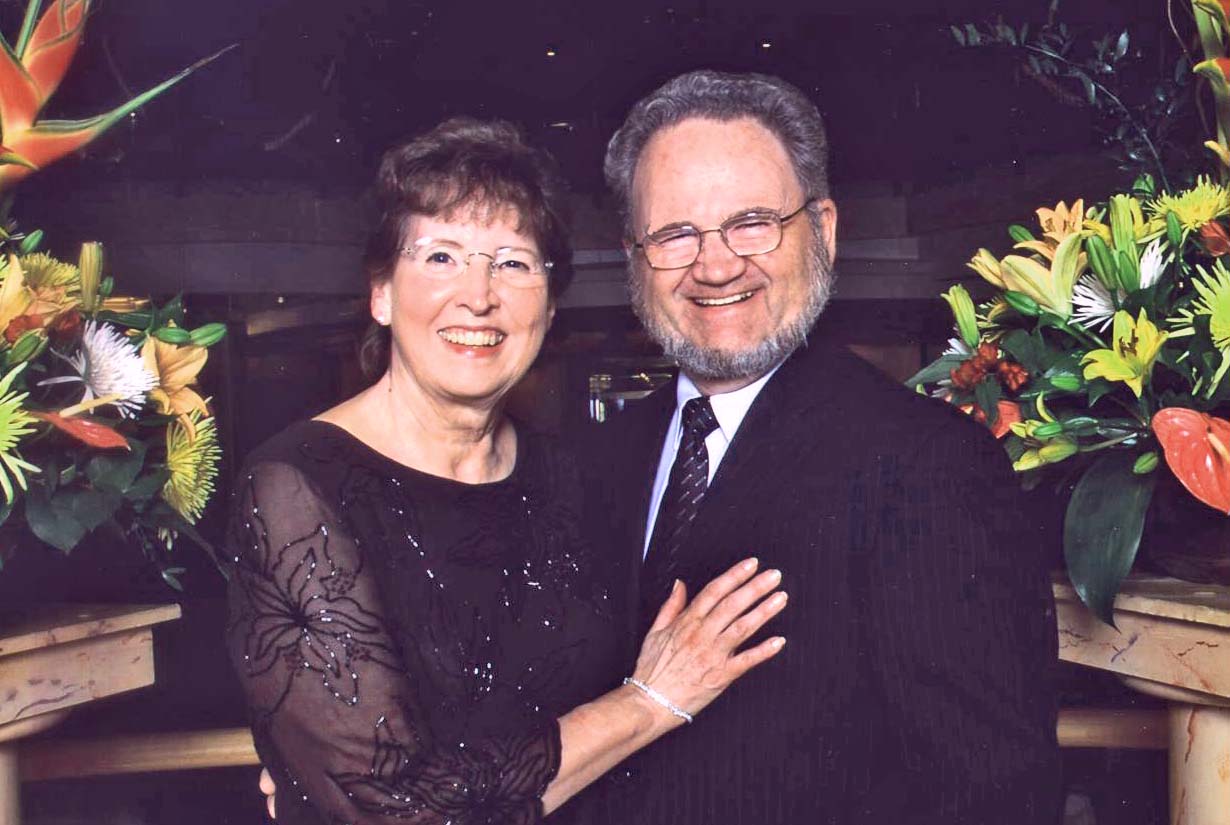
Our
evening dinner was a bit of a disappointment. The food was
excellent, but we were seated with two other couples. The one couple
was from Chihuahua, Mexico, and spoke very little English, but the
lady spent most of the evening proving it. The other couple
basically was rude. They literally rejected any attempts on our part
to talk, let along say “hello” to us when we all sat down. Rosalee
and I found it easy to skip the dessert tonight and get an early
seating for the first show... THAT'S a first, for sure. Actually TWO
firsts. We never meet anyone that is just plain rude.
The big
evening show was Piano Man, with some excellent piano work by the
ship’s orchestra’s piano player. The singers and dancers performed
to work by Liberace, Manilow and of course, Elton John. It was quite
good. Every seat in the house was occupied twenty minutes before
show time.
The second
evening show was in the Vista Lounge, at the other end of the ship,
but we had an hour to get there so it was not difficult. The
entertainer was billed as “Comedy juggling and other useless
skills”. He juggled knives, bowling balls, bean bags, open-bottomed
tapered cups, all together at the same time eventually. He closed
the show using THREE of those little paddles with rubber balls
attached with rubber bands (Paddle-Ball?), while balancing a bowling
ball on his forehead. Don’t ask. LOL. |
|
Day
Three: 21 April, 2007, 1300 hours GMT (0900 ship time)
|
Ship’s Position: N 16° 29’, W 73° 15’, on a course of
141° (SE) at 18.6 knots. bound for Oranjestad, Aruba.
During the night we dropped further south, leaving the
Gulf of Mexico via a passage between the south-eastern
tip of Cuba and the island of Hispaniola (now Haiti and
the Dominican Republic)and entering the Caribbean Sea.
We are currently 792 nautical miles from Ft. Lauderdale
and 308 nautical miles from Oranjestad, Aruba. The
temperatures, wind speed, barometric pressure and
forecast remain the same as yesterday.
|
This is
another “at-sea” day, but it is not a “formal” dinner night. We will
go to dinner a little earlier tonight, to avoid the rush and
possibly miss the “Mexican Wonder” and the “Boorish Two-some” from
dinner last evening. The menus are different every night, and they
offer many excellent choices. There are no prices on the menu of
course, since the food is part of the cost of the ticket, so it is
fun to select any or all. There are choices for various restrictive
diets, and the staff will do some other modifications if you ask
them.
There was
a time on another Princess cruise that they had “BOTH my favorite
meals” listed on the same night. I commented on it to our waiter,
but ordered the Prime Rib (of course). He delivered a complete King
Crab meal with it also. I tried to share that… no way could I put
them both away. If you ordered the Triple Decker Obscene Chocolate
Fudge Brownie with Coffee Ice Cream and Whipped Cream with Shaved
Almonds and a Cherry on the top, but your table-mate’s Burgundy and
Raspberry Crème’ Brule’ looks good too, just ask and you will
receive that too. Bon Appétit’ (that is the French translation for
“Burn your WeightWatcher’s Book”).
Later in
the afternoon we noticed that we had slowed noticeably (not the
eating but the ship herself), but that is probably because we were
close enough to our destination that we had plenty of time to get
there. We don’t disembark into Aruba until 0800 tomorrow anyway. A
check of the “Report from the Bridge” on the cabin television
indicates our speed is 13.7 knots.
We stopped
our daily walk today to enjoy some “Caribbean-style” musicians
playing next to the pools and soaking tubs on Lido (14) Deck. We
were sitting at the Topsiders’ Bar & Grill on the Sun (15) Deck,
looking down onto the band. There is another deck with a “Splash
Pool” that would be deck sixteen, but it is only at the front of the
ship, and it has no “name” given to it. At the rear (at the same
level) there is a small area that is called the Sports Court where
you have fencing to keep the balls (and players??) on board.
For our
evening meal we were seated at a table for eight (table number
eight, as a matter of fact), and the other diners were wonderful
people… a joy to be with. One couple (Walt & Janet) are from
Seattle, and he is retired as an engineer from the broadcasting
engineering field. He was (and still is occasionally) heavily
involved with radio and TV transmission systems, antennae,
microwave, etc. A second couple is Janet’s younger brother Dave (an
accountant) and his wife Pat. They are also in the Seattle area, but
live across the sound on 'the island'. A third couple was two ladies
from Arizona: A second Janet from West of Phoenix and Helen from Sun
City, Arizona. After dinner Walt and I continued talking out in the
open area for half an hour. Janet was surprised that Walt had found
anyone that he wanted to talk to. He is a quiet gentleman, but Janet
has just never met anyone quite like me I suppose. :-)
Somewhere
Walt and Janet had gotten attached to the waiters at table eight,
and though we are in the Personal Choice dining room for “anytime,
anywhere dining”, they come early and ask for that table and those
waiters. They invited us to join them as part of their “group”. They
don't 'reserve' the table each night... they just come early enough
before they open the dining room, and ask for table 8. |
|
Day
Four: 22 April, 2007, 1100 hours GMT (0700 ship time)
|
Ship’s Position: N 12° 32’, W 70° 04’, on a course of
111° (SE) at 5.4 knots. North of Venezuela, we are about
to dock next to Oranjestad, Aruba. Barometric Pressure
is 29.9 in. hg. and the air temperature is 80.6°F.
|
The Island
of Aruba is one of a group of small islands just off the coast of
Venezuela, which is 20 miles to the south. The island is 117.6
square miles, with just over 85,000 people living there. A fourth of
the island is densely covered with business and residential
buildings (at least six new high-rises are under construction as I
write), maybe a third is covered with rough-looking homes built
mostly of masonry and stucco, and the rest of the island is pretty
much open land, with ”soil” that is basically white sea-floor on top
with black volcanic rock lifting it up. Some black is fully exposed.
This island is not the result of a volcanic eruption, but rather was
lifted by a flow that did not erupt to the surface. The major
productive reason for Aruba to exist? Tourism. Planes fly in at a
regular rate and the cruise ships continue to pull into port. Some
years ago there was a huge petroleum plant built here, but it is
gone now. Gold was discovered here close to the time that Sutter
found it in California, and they took out over three million pounds
of it, but it is exhausted now. The city can be seen in the distance
in the photo.
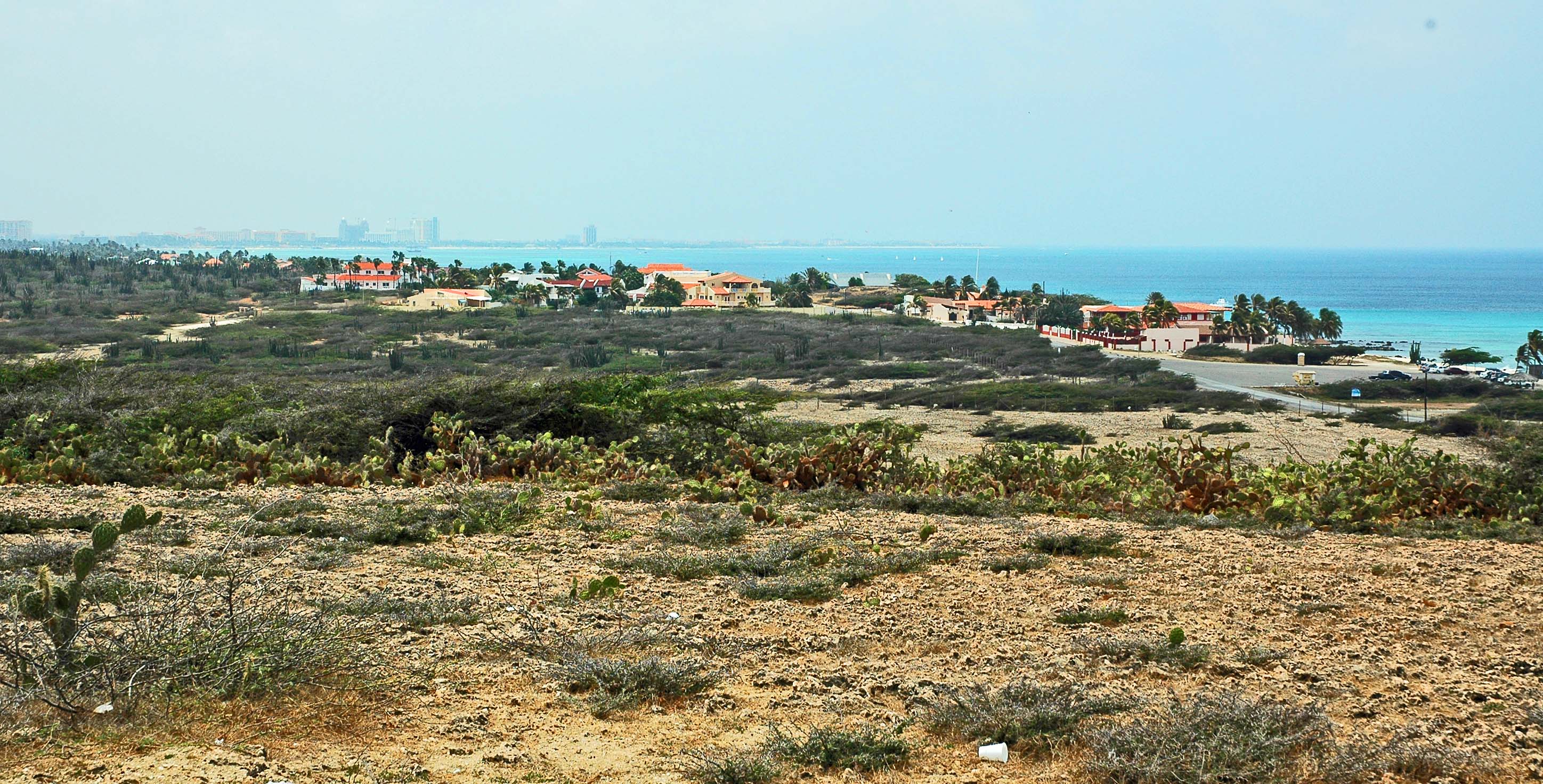
We went
ashore for an 0830 tour across the island that would include a look
at their famous rock (… uhhh… ok…. it is twenty feet tall and you
can walk up on it), and a famous rock “bridge” that is naturally
formed along the coast. It would have been beautiful, had it not
collapsed and fallen in 2005, but we did get to see the “baby Rock
Bridge” next to it, which you could almost walk under. Next we got
to visit an Ostrich Farm, where we were treated to the (sniff?)
bouquet of fifty ostriches, which was memorable. The tour was
interesting. They are not natural to the area, but they raise them
there. The weather requires them to incubate the eggs to get them to
hatch. Our guide that took us through the ostrich pens was a girl
about 25 years old that seemed to really know her stuff about the
birds. I asked her how far we were from the Equator, since we were
all cooking our brains in the sun. She spoke excellent English, but
she had no idea what the “Equator” was, OR how far away we were from
it. A nearby fellow passenger shared with me that we were ten
degrees north of the equator, which translates to 26,000 miles
circumference divided by 360° in a circle and multiplied by ten
degrees north of the equator… hmmm… ok.. you do the math. YOU have a
calculator. LOL.
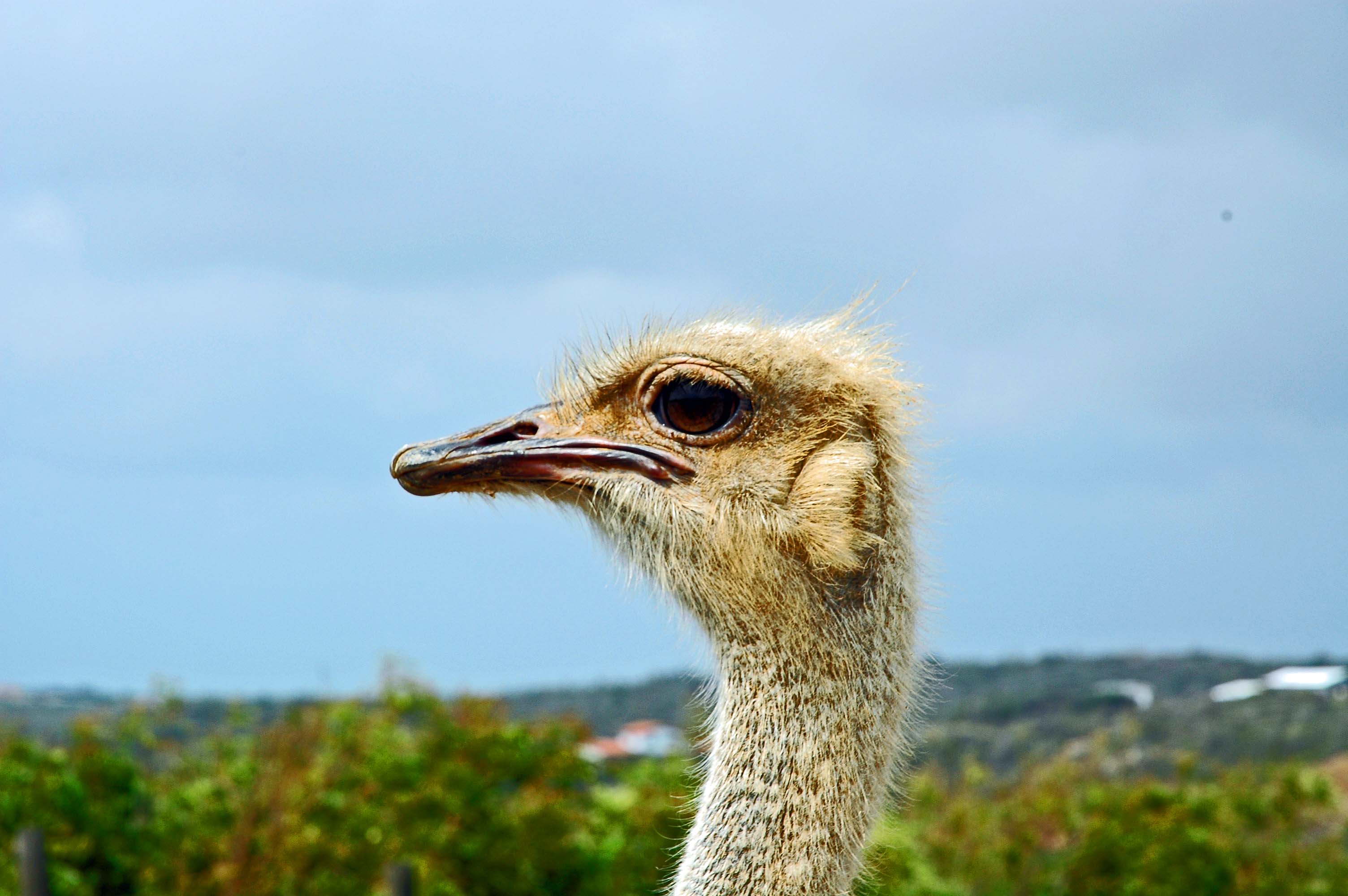
We also
drove to the base of the “California Light House”, which was so
named by the fact that a worker was enthralled by the “California”,
a good looking ship that passed the point when they were working on
it or planning it or something. I was also told that the
“California” lies at the bottom of the sea nearby. It is a beautiful
lighthouse, anyway. From there we drove back to the ship, through
the “expensive” portion of the island. A small family home there
would be a cool million dollars, while in other parts of the island,
the same home would go for about $125,000. Something about LOCATION,
LOCATION, LOCATION.
We joined
our new friends at Table 8 again for dinner. Helen and the other
Janet had other plans and let Walt & Janet know earlier today, so we
did not wait for them. Another delightful couple from Canaveral, FL
(Dick and Martha, who prefers to be called by her middle name, Mione
– pronounced “My Own”) joined us. They are older and good
conversationalists. They were invited to join us the next night as
well. This is the group. The two in the front are Mione and dick.
Across the back. from the left, are Walt & Janet, then Dave & Pat,
the Ken & Rosalee.
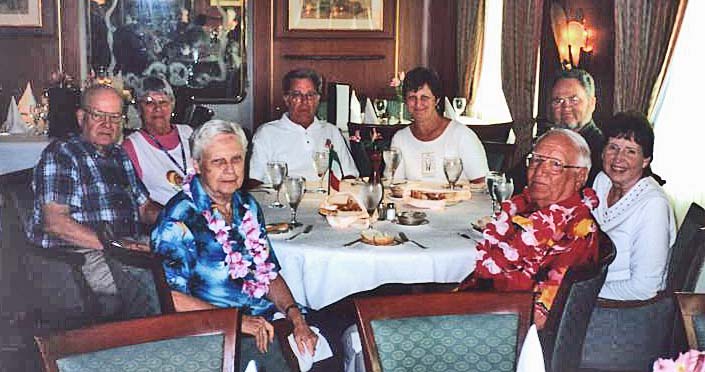
|
The menu was what I referred to as
the “Ducks, Frogs and Snails” menu. Duck a’ l’Orange was
one of the entrée’ choices, as well as a Frog’s Legs
entre’ and their wonderful Escargot that Princess does
so well. If you have never had those little critters
before and want to risk everything and try it “just
once”, a Princess Cruise is where to try them because
“they just don’t get no better’n these”. Rosalee and I
both selected the Beef Tournedos that were delicious.
For the first evening this cruise, we had our beloved
Crème’ Brule’. It was a Raspberry flavor and it was
wonderful.
For the evening
entertainment we caught Tony Cherry in the Princess
Theater. We really enjoyed his program. He is a singer
that sounds good when he sounds like Tony Cherry, and
does a wonderful Louis Armstrong when he does “Mack the
Knife”. He does a lot of Bobby Darrin stuff, Dean
Martin, Paul Anka, Sinatra and others of that era.
Titles like “Beyond the Sea”, “Venus”, “Release Me”,
etc. were done very well.
I decided to go
in and catch Tony Cherry for a second (repeat) show
during the second show time, and sat next to a couple
from Denver. He retired from Caterpillar Tractor a few
years ago. His dad worked for J. I. Case, another
tractor pioneer. Tony was just as good the second show,
but the show was different, because he does a lot of
comedy in his act and there was a ditzy blonde idiot in
the lower-left corner of the audience that “lives” on
negative attention, the same as some “class clowns” do
in a classroom. This was the third show of the cruise
where she has shown up after the show started… made a
big production about coming in and getting her friends
to join her… and then commenced to “join” the show by
talking to the performer. The whole act was changed
because of her, but Mr. Cherry did a great job of
“playing her”, to the benefit of the show. When she did
the same thing in front of the juggler with the huge
knives he was tossing around, we hoped that she would
get seriously involved with that act but she stayed
clear. Darn! Oh well, she will be back, for sure. |
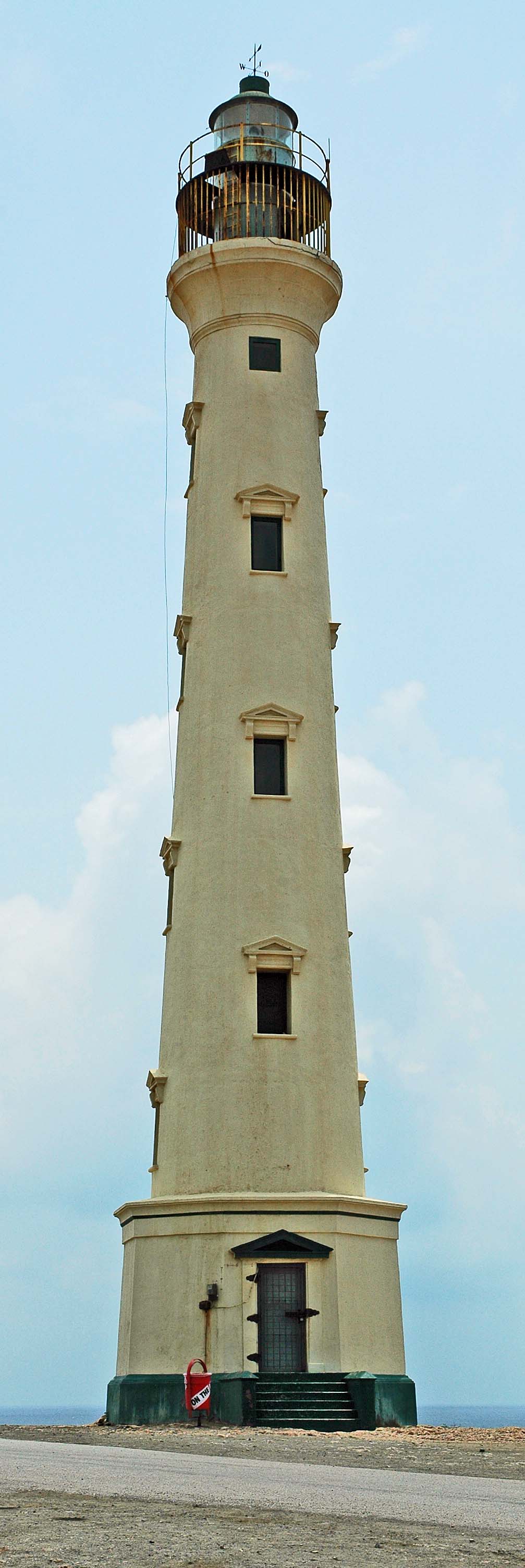
|
|
Day
Five: 23 April, 2007, 1230 hours GMT (0830 ship time)
|
Ship’s Position: N 11° 40’, W 74° 24’, on a course of
249° (SW) at 17.6 knots, bound for the Panama Canal.
Total cruising distance from Ft. Lauderdale, Florida is
1371 nautical miles, with 383 to go before we reach the
Canal Zone. Barometric pressure remains around 29.8
inches. Later in the morning we will be told that the
outside temperature (80.6°F) and the water temperature
are the same. That seems strange. We’re talkin’ OCEAN
here, folks. |
Last night
we cleared the northern tip of the South America continent at Punta
Gallinas by ten miles and headed more to the south through the
Caribbean Sea, along the coast of Columbia. The ship’s clock will
change tonight, moving back an hour.
Rosalee
and I were a bit lax with the exercise portion of this cruise
yesterday, due to the heat, humidity, feeling washed through a
wringer, laziness and excess food stowage. We did the walking today,
since we are at sea again all day (not a formal night tonight,
however). So, after taking the 32 vertical steps up to the Lido deck
where the Horizon Court is located (where we enjoyed breakfast), we
went down to the Promenade Deck and walked the perimeter of the
ship. Three times around constitutes a mile and we actually made six
full laps today. We were doing some serious bribery to ourselves to
make those laps… from the first to the last. We still do not have
our walking legs back from not walking enough at home.
After the
walking, we stopped in the Photo Gallery to look at the pictures
that the photographers were taking last night as we exited the
dining hall. A male and female pirate absconded us and “forced” us
to be photographed with them. We stopped to see if they were ready,
which they were. We decided to let them re-cycle the photos. There
is no fee unless we wish to keep the prints.
Requiring
some liquids before we took the ninety-nine stair-steps up to our
cabin, we had to circum-navigate the Art Auction that was pretty
much taking up the center of the ship, and found refreshment at the
bar in the Atrium on the Plaza (5th) Deck. While there we
met and visited several different couples. One was a retired teacher
from the east coast and her blind husband who retired from being a
computer programmer. Another was a couple from Arizona and their
friends from Chandler, Arizona. They offer colas at the bars, but
you have to pay for drinks.
I think
that we actually skipped lunch today. It’s hard to tell, since we
never get hungry. We went up to the cabin to relax a bit and we
might not move again until time to go to dinner. We will meet the
“Table # Eight” group a little after 1700 hours.
It was not
too difficult to choose from the menu tonight… Lobster Tail. All but
Mione... she was the only one that chose a different entrée’. It was
very good. |
|
Day Six: 24 April,
2007, 1500 hours GMT (1000 ship time)
| Ship’s
Position: N 9° 11’, W 79° 52’, on a course of 68° (NE).
We are bound for Amador, Panama, an island in the
Pacific, just off Panama City. It is connected to the
mainland by a paved road on a causeway made from
materials pulled from the major cut in the Continental
Divide to let the Panama Canal to come through. Total
cruising distance from Ft. Lauderdale, Florida is 1750
nautical miles behind us, with 14 to go before we reach
the canal. We are getting some rain, so standing on an
open deck to witness the action around the locks is a
bit “iffy”. |
It is amazing to me that
with all of the education that we have during our youth, we never
really learned very much about the Panama Canal. We never knew, for
instance, that the French people attempted to construct the canal in
the latter part of the nineteenth century, failing because of their
miss-guided belief that they could make the fifty-mile crossing with
a “sea-level canal”, using no “locks” to lift the ships. Other
things stopped their project as well, including the lack of funds to
complete the project and the loss of many more then the reported
twenty thousand lives to the mysterious Yellow Fever and Malaria. It
was about the turn of the century when the world learned that
mosquitoes were responsible for the transmission of the diseases,
and we learned about ways to combat the diseases once they were
contracted.
The United States realized
the political and potential national defense benefits of the canal
about the same time and after purchasing the French interests, we
finished the canal in 1914, just in time to use it to move materiel
and troops to help in World War One. The Panama Canal is essentially
functioning exactly as it was designed and completed nine decades
ago. Ships are lifted about 85 feet at each end of the canal by
sheer water pressure in locks, and through the use of some
excavation through the Continental Divide and a couple of lakes,
transfer the ships from the Caribbean Ocean to the Pacific Ocean in
about five and a half hours. A reservoir in the mountains releases
water into the center of the canal that flows to both ends, where
the locks use valves to allow water to fill the next lower lock,
using essentially no pumps to move the ships. About ninety-three
million gallons of water are used to move each ship through. The
project was one of the first major applications of the new process
called “concrete”, and the nearly one mile long Gatun Locks at the
north end of the canal was the largest concrete project in the world
until the Hoover Dam was built in the thirties.
As we
approached the canal early in the twilight, we entered from the
north end of the canal, and were given the code name of “S-ten-zulu”,
which meant that we were SOUTH-bound, number TEN in line for the
day, and a passenger ship (ZULU). We passed up thirty-six ships that
were waiting at anchor for their codename to be called to progress
through the canal. Princess was able to proceed through because they
paid the premium of $0.37 per ton some time in the past, to move to
the front of the line. The total tariff of our passage through the
50-mile canal: $188,000 and change. Hmmmm. And we gave this canal
away?
A local woman came on
board and described the fascinating details to us over the ship’s
inter-com system as everyone crowded the rails for the entire
transition. It was made even more meaningful by the good fortune we
had by the Coral Princess going through the adjacent set of locks
(two parallel sets at each end), allowing us to see what we
essentially looked like were we standing on the dry land watching
everything happen. It was sobering when she said: “You will notice
that the Coral is a very tight fit, with very little clearance on
either side. If you think that is snug, we are one and a half inches
wider then the Coral is.” She was also helpful in being there to
tell us the names of the two crocodiles that were watching us go by. We can watch as the Coral
Princess proceeds and we are right behind her.
To
facilitate faster handling of ships, the morning is dedicated to
south-bound ships only, and the afternoon is for north-bound ships.
In the evening and all night long, ships go both ways at the same
time. The “PanaMax” ships (maximum width (106 feet) and maximum
length (985 feet) are handled only in the daytime, since they cannot
pass in some parts of the canal.

Dead ahead of us is our
first lock which has the water level at the level of the beginning
portion of the canal... which is the height of the Caribbean ocean.
There is a small bridge running across blocking our entry, but it
will be pulled away as we approach. That is how autos and trucks get
from North America to South America. There is another chance further
inland.
Notice that the gates are
closing behind the Coral. When they close the water in the next lock
will drain into the first lock. lifting the Coral high enough to
move forward into the second lock. In our channel, the gates that
are white along the top are our gates between lock number one and
number two. Above that are some reddish gates that separate number
two from number three. There is a ship that is yellow colored in
lock number three, heading in the same direction we are. Notice the
row of lights on the Coral's Promenade Deck (large openings in the
steel) are just a little higher than the sides of the canal.
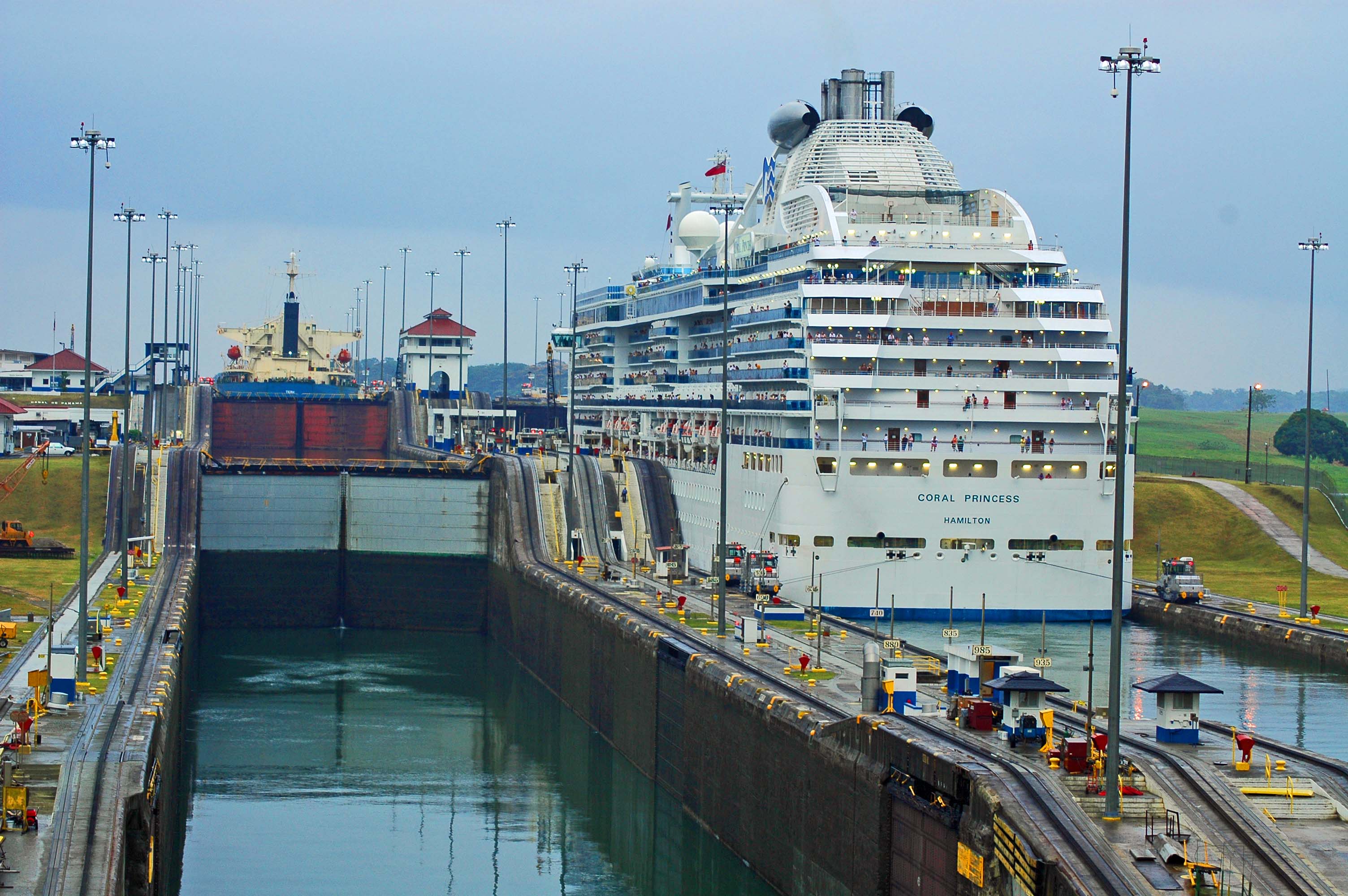
Now look
at how high the lights on the Coral are from the sides of the
canal... she has lifted completely and the gates into the second
lock are open. She is moving into the second lock. We are pulling
into our first lock. Notice that the Coral has two small electric
engines (referred to as 'mules' sometimes) at her left rear corner.
There are two on the right but one is forward enough that we cannot
see it. There are two on either side at the bow as well. Their
purpose is to hold the ship in position as it moves forward through
the canal. The ship actually moves itself forward, and these engines
provide the steerage so the hull does not scrape the walls. The
engines weigh fifty tons each.
Amazingly, with literally
inches on either side of our ship, she was under her own power going
through the locks. Two (2) Fifty-five ton electric train engines
(called “mules”) were located at each corner of the ship, holding
her hand to keep her centered and to serve as her “brakes” at each
lock gate. These mules are electrically powered from a third-rail
and have a “cog” drive system for climbing the ramp to the next lock
level. The originals were built with a cab at each end and cost ten
to fifteen thousand dollars. The newer ones made by Mitsubishi cost
about two million apiece. I personally could see more then one
hundred of these mules in various states of repair (as well as very
old, outmoded ones)… that’s a lot of engines at that price. It
can take over an hour to transverse the first three locks, all
located in the same concrete complex.

You can
see that the Promenade Deck lights area even with the edge of the
lock again, but she is in the second lock now. The Yellow ship ahead
of us is pulling away into the lake and headed to the Pacific Ocean.
The gates will be closing soon behind the Coral. We are moving
forward into our first lock.
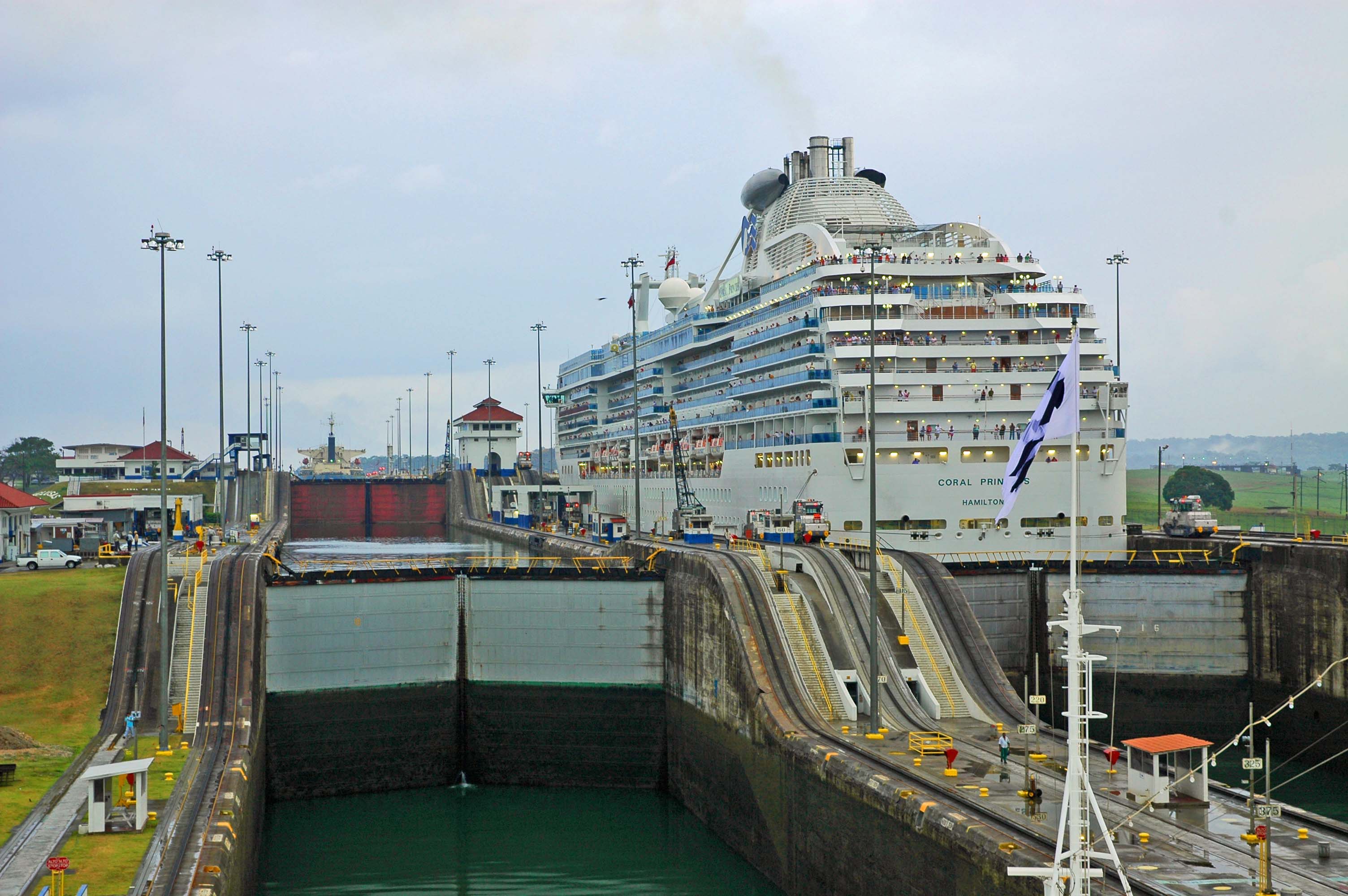
The gates
are closed behind the Coral and notice that she has lifted quite a
bit already... check the height of the lights above the side of the
canal. We are further into our first lock.

The Coral
has moved into the third lock. Notice the height of the water in the
second lock behind her. Her rear gates are closing and she will soon
be lifted the final forty feet to the level of Gutun Lake, which we
can see directly ahead of our third lock. We are pulling into our
second lock.
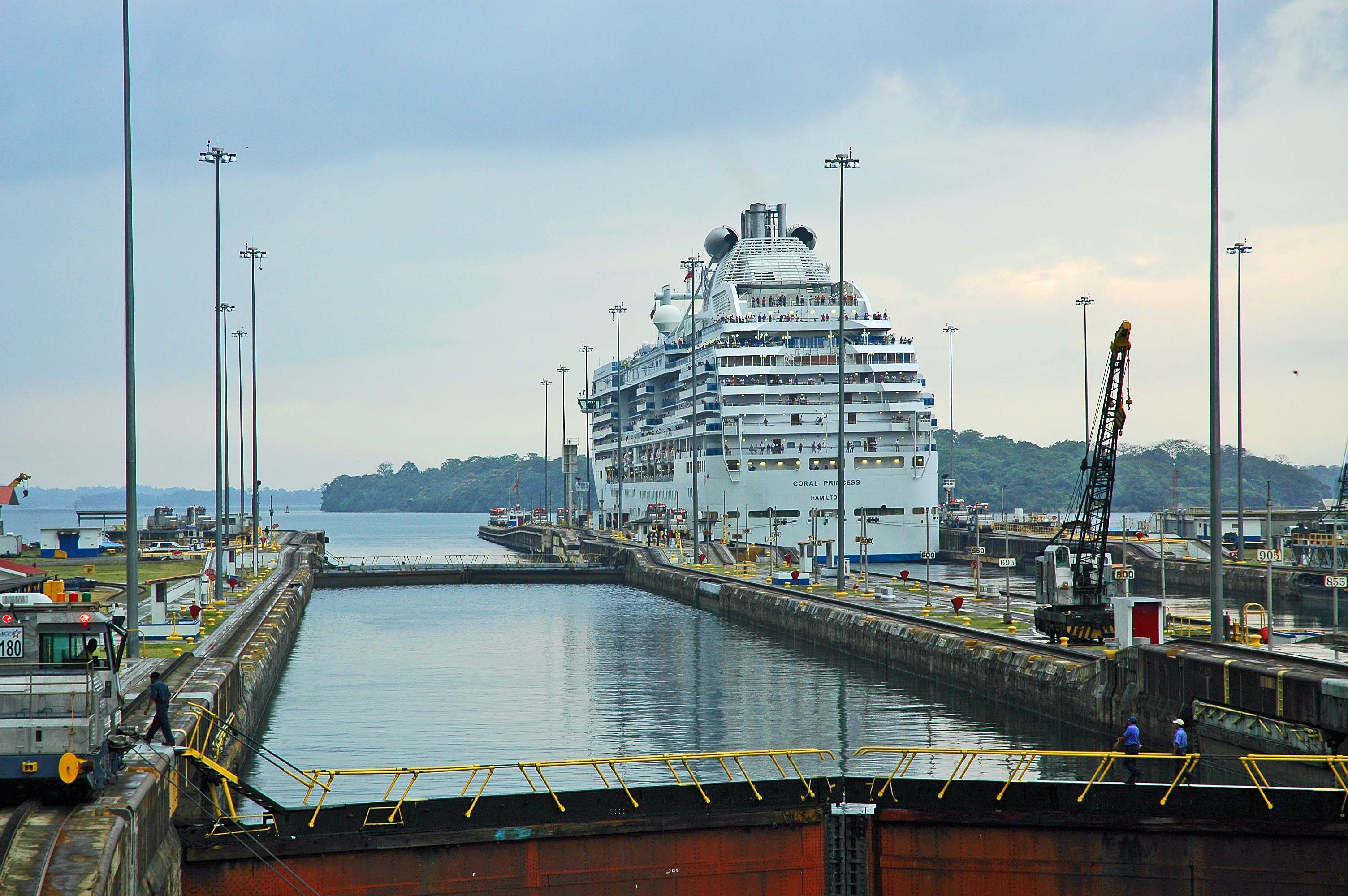
Coral
Princess is exiting her third lock. We are being lifted in our
second lock, and our third lock is still full. That water will be
coming into our second lock to lift us. When the water levels match,
the lock gate will open and we will move forward. One of our mules
can be seen on the left of the image.
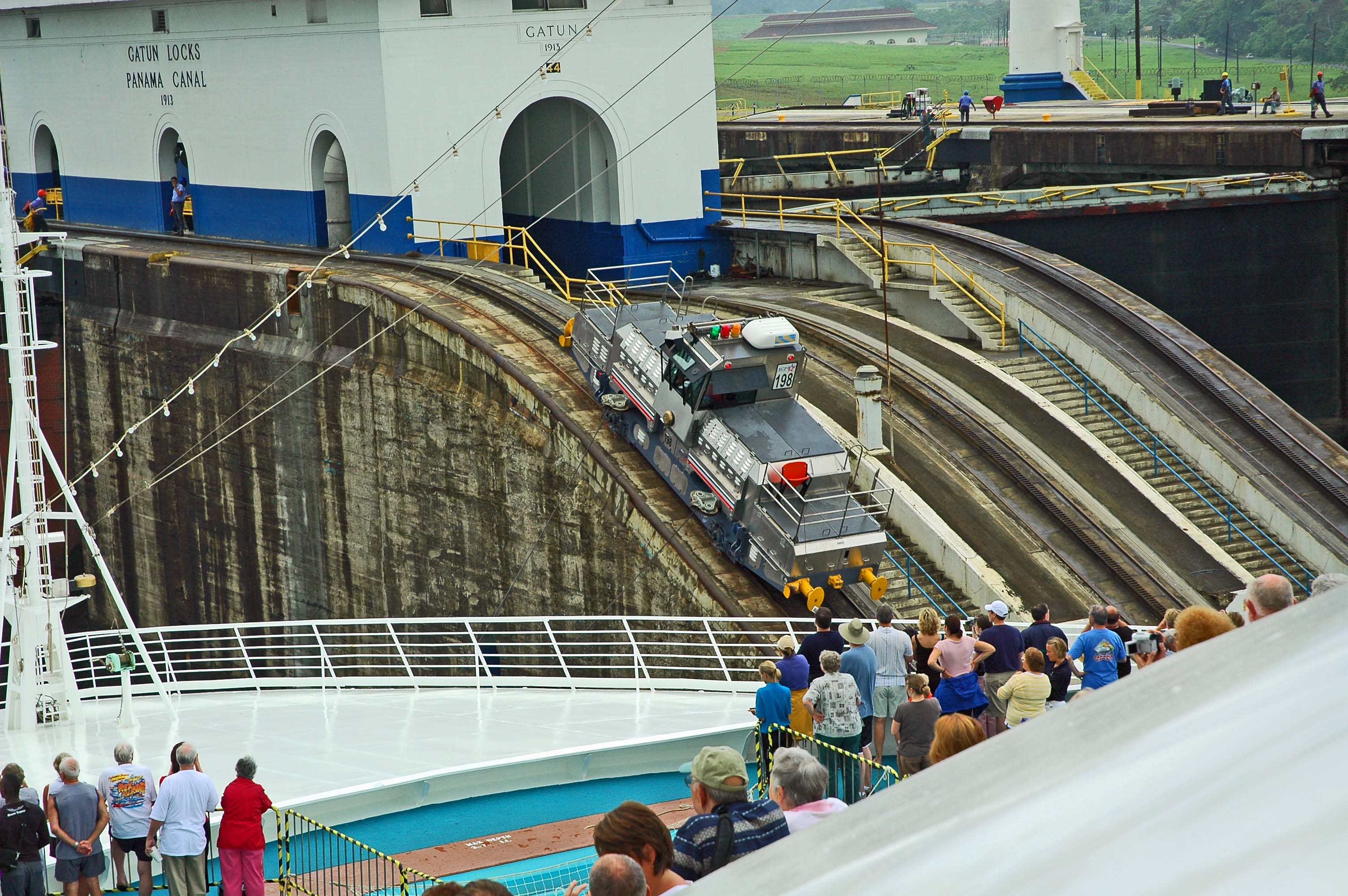
Here we
can see one of our mules climbing up the slope to the next level.
They use a cog wheel drive to do that steep climb.
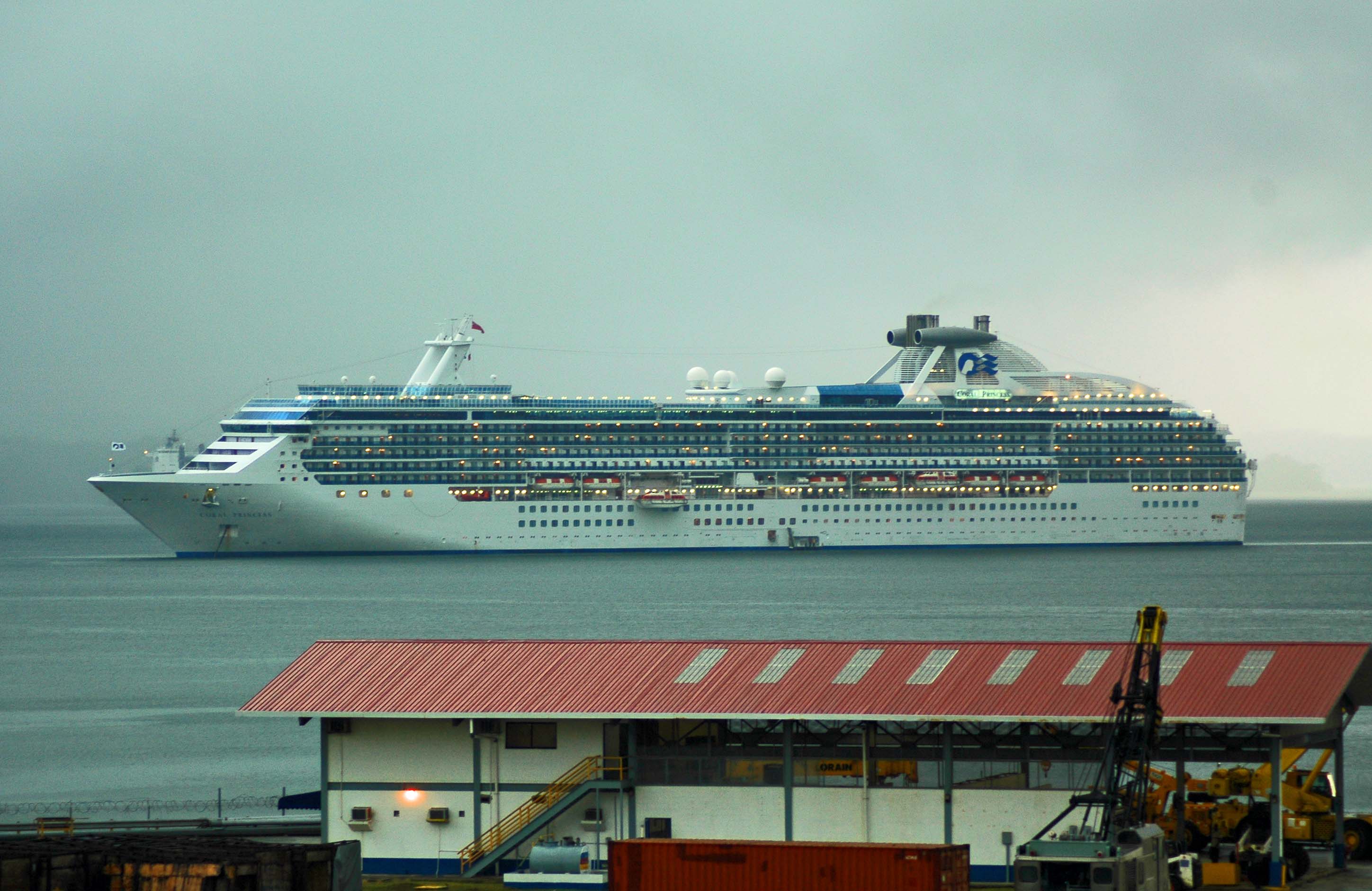
Coral
Princess pulled to the port side crossing our path before we were
clear of the Gatun Locks and dropped anchor in Lake Gatun. You can
see she has opened her platform amidships on this side and she is
dropping one of her tenders to allow passengers to go ashore for
some excursions. The Locks are actually part of a man-made dam
system that causes the waterway to fill and create Gatun Lake. The
lake forms a large portion of the Panama Canal. The rest is dredged
out so that it becomes a canal.
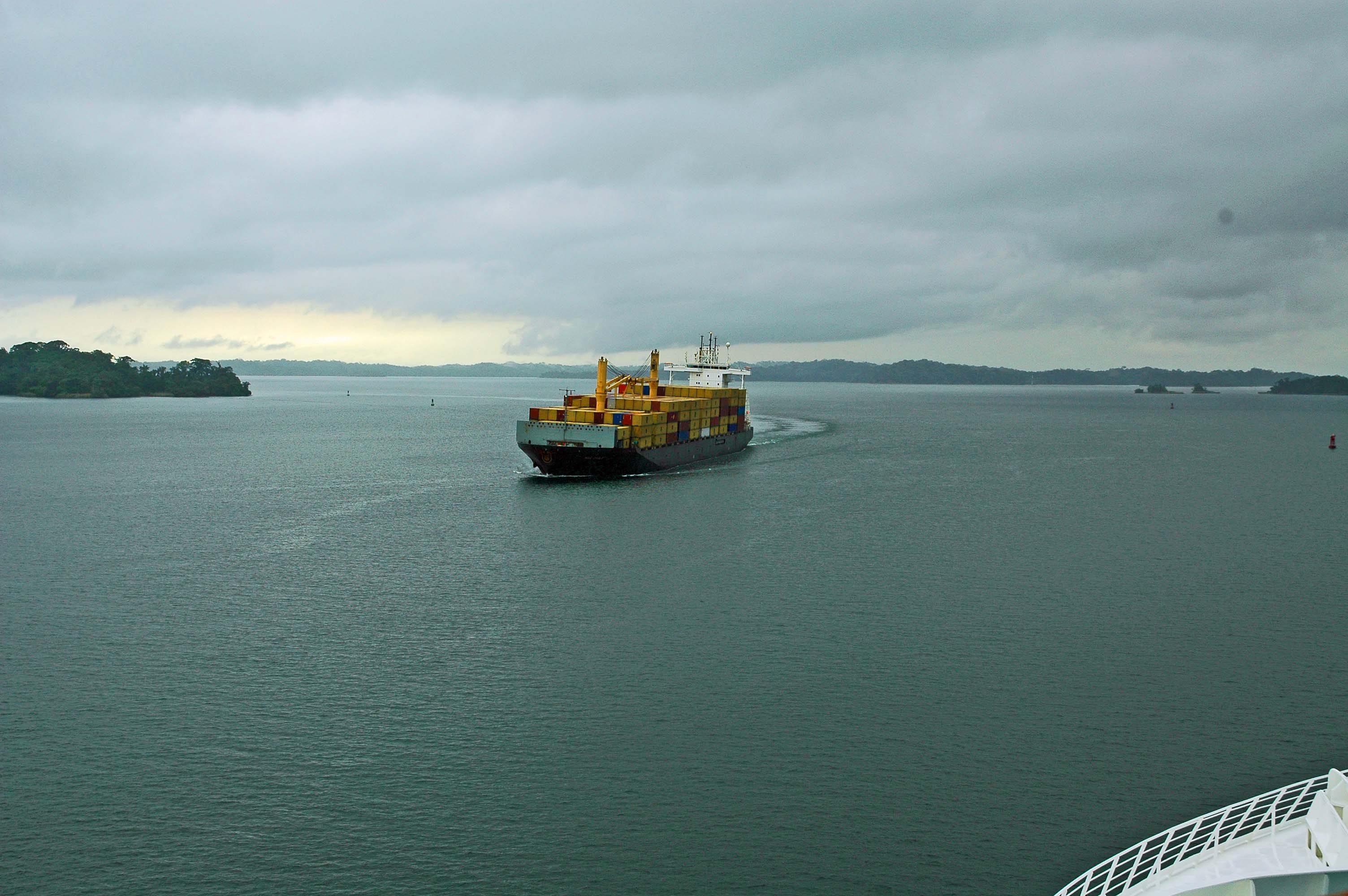
We are
headed south, across Gatun Lake. Channel markers direct us to keep
us in the deepest part of the canal.
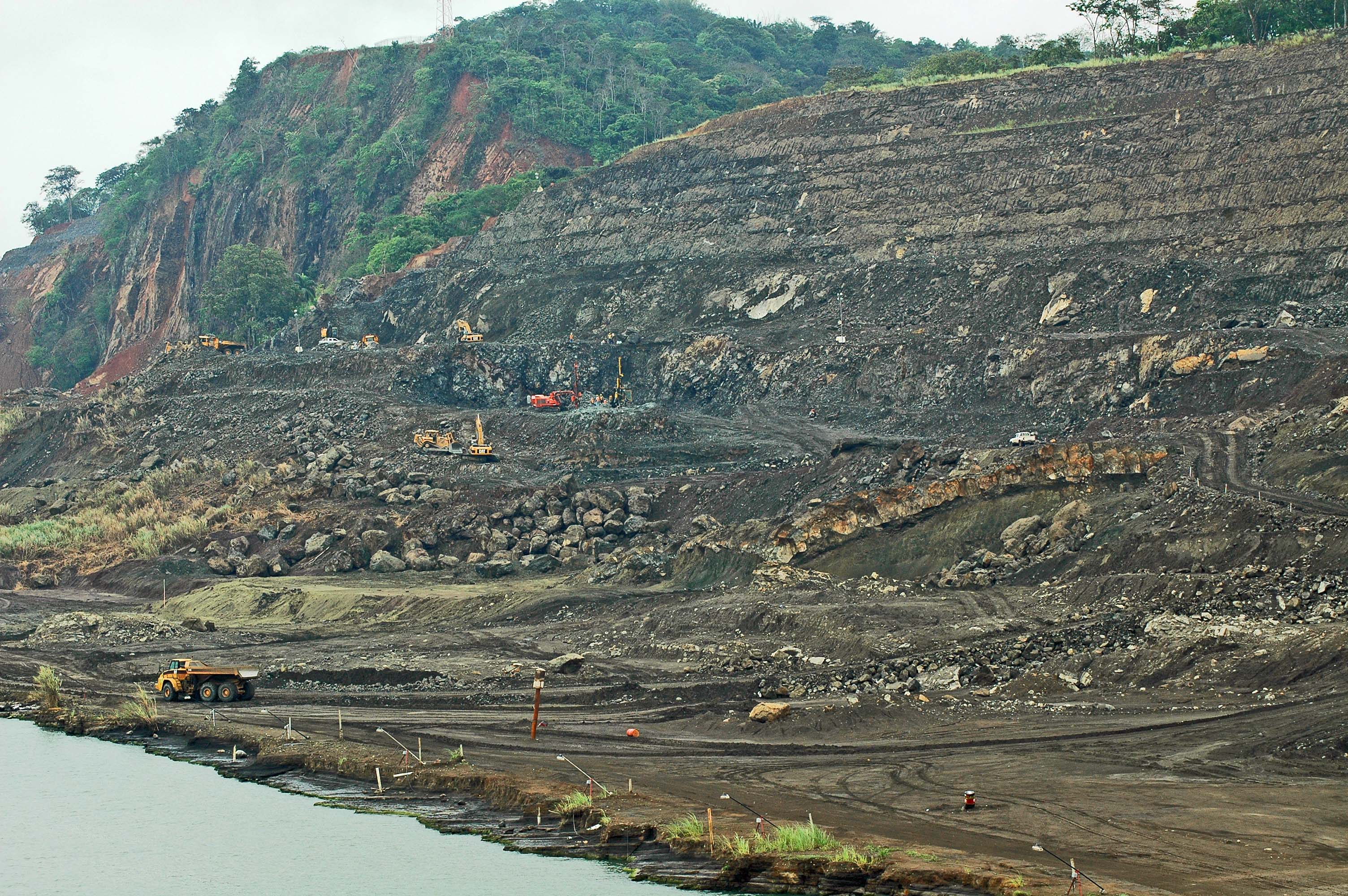
Where the
canal passes through the Continental Divide, the mountains were just
so high, they had to remove massive amounts of soil. To make it more
complex, the soil sits on rocks which set on slippery stuff... it
all is unstable and slipped and filled in the excavation several
times before they got it under control. Men died and equipment was
lost each time it slipped and came down. As you can see, it is a
continual process to keep the hills under control. That water's edge
is the edge of the canal.
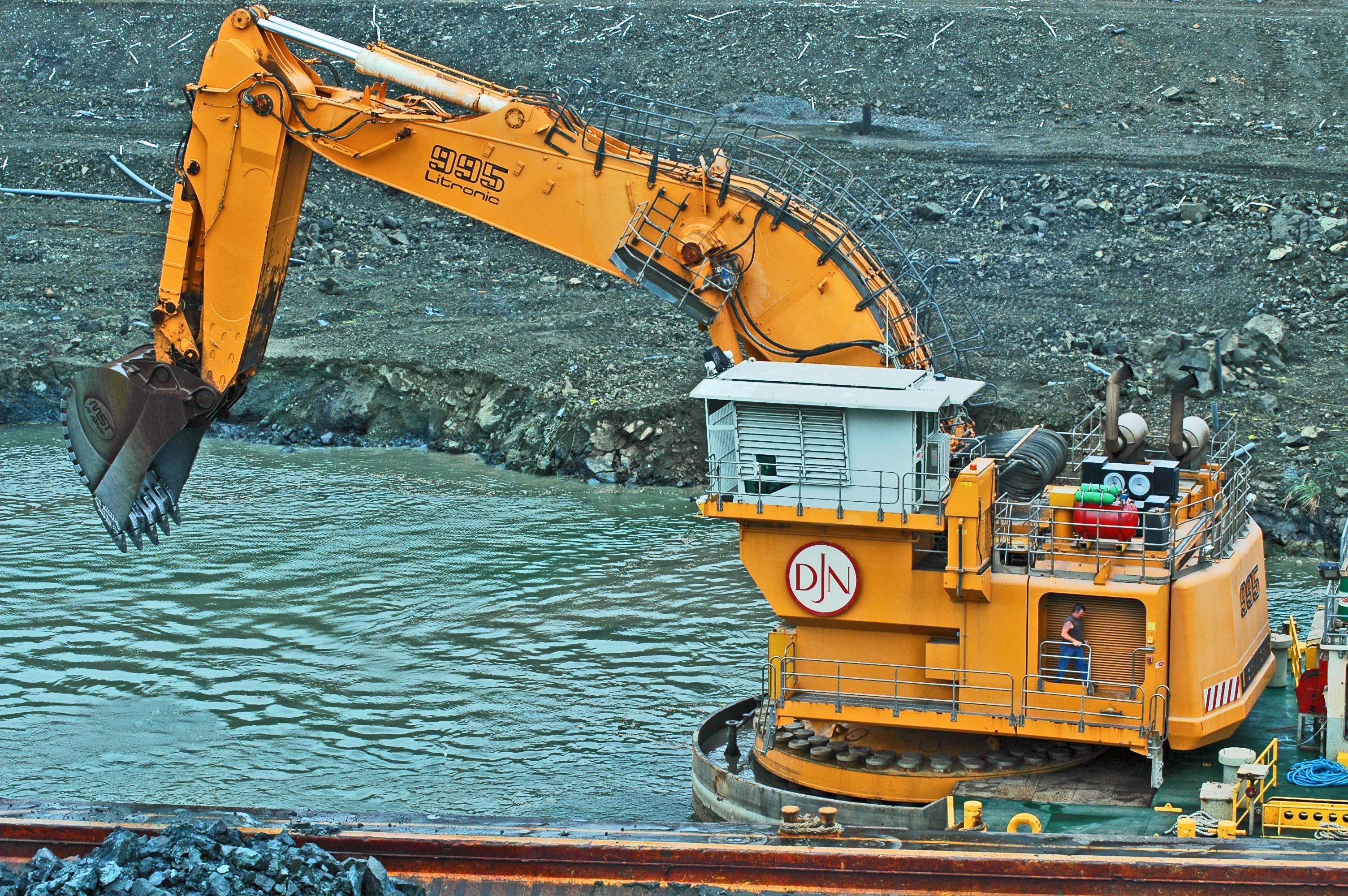
Various
floating dredges and buckets are constantly working on keeping the
canal clear. Look closely at the square hole in the side of this
backhoe, lower right corner. See the operator walking in there. He
has to climb all the way up to the grey shed at the top to operate
this machine. Look directly above the man and you can see two huge
mufflers and exhaust pipes. There are two very large engines running
this monster. The machine is floating on a barge and it is lifting
rocks from the bottom of the canal and putting it into a barge just
at the bottom of this image.

A
beautiful, simple, suspension bridge runs over the canal near the
Continental Divide, to transfer automotive traffic between North
America and South America. That is a single set of suspension
cables, attached to the roadbed in the middle between the
north-bound and south-bound traffic.
Once we cleared the last
locks, we berthed just off Amador, Panama, a small island connected
to Panama City by the causeway (which was built by the tons of soil
carried by trains out of the excavation). If you thought that Panama
City was a "sleepy little Mexican Town", think again. It is far from
that. The skyline of Panama City is
gorgeous. It has tons of high-rise buildings. If I did not know
better, it could be San Francisco or New York City that I was
looking at. One and a third million people in Panama City we are
told… sixty-percent of the population of the country.

Well, we had another
cruising-first for us. We booked an evening tour on land, so we had
to grab dinner early (a cheeseburger and fries by the pool with a
hot-fudge sundae to top it off). At our pre-excursion meeting, they
were explicit about the fact that “…the last tender would be leaving
the dock at 2130 hours (9:30) SHARP! We sail at TEN!” They were 30
to 45 minutes late getting us off the ship, so when we started the
bus ride to the Miraflores (southern) Locks, and the tall black
Panamanian guide on the bus said “I have you for tree hours, mon!”, I knew we were in
trouble. I spoke up (as did others) with the fact that "...we had to
be back to the dock by shortly after nine pm… and NO LATER!", and he
said “Aaaaaaayyy… no pro-blem, mon. They no leave on time… we be
back 9:30 tops!” Panic sets in at this time. Big boats don’t sit
around waiting for slow-pokes.
The tour
through the museum and visitor's center at the locks... which we had
just come through... was interesting. Lots of exhibits about the
history of the canal and the area. We were also able to walk out
onto an observation deck to observe both lanes of ships to pass
through the gates.
A young
man was standing behind a circular information desk, and he was
fielding questions quite well. Some visitors had one concern for
which they were seeking information. And that was about the recent
transfer of 'ownership' of the canal from the USA to the people of
Panama.
I
mentioned earlier that for a couple of decades in the late 1880's
the French people tried really hard to build the canal. They
invested about $40 million in their attempt but the diseases and
loss of life, as well as the insurmountable task caused the French
to cease operation. The Panama area was being fought by Columbia, so
Panama seceded from Columbia and signed a treaty with the US to
build the canal. To 'make it right' with the French, the US bought
the French 'rights' for the full $40 million. They got nothing but
the rights, because all machinery was outmoded and rusted solid.
Most work done had to be re-done.
The US
invested another $400 million and took a decade to build the canal.
They chose to put in the three locks to reduce the amount of
excavation they had to do. The canal is a little more than fifty
miles long. Multiply that times the 85 feet deeper they would have
to go without the locks, as well as the soil from the mountains that
have to slope away from the canal, and that's a lot of dirt.
Manpower
was brought in from many different countries because only locals
could tolerate the jungle heat and moisture... and insects. Tens of
thousands of men died from the efforts. It was the US Army doctors
that determined that the malaria and other diseases was being spread
through lack of sanitation and abundance of mosquitoes. They
literally eliminated mosquitoes in that part of the jungle and they
got control over the bugs.
The US was
deeded a strip of land ten miles wide that followed the predicted
path of the canal, and they installed a massive railroad system, a
large dam to control massive water runoff from the mountains (which
operates the canal today), and support buildings, hospitals,
literally small cities. The concrete to make the locks was a new
invention and it was a large-scaled test, which has proven itself
for a full century.
Over the
last forty years the US has been gradually turning the "Canal Zone"
as well as the operation of the canal over to the Panamanian people,
and at noon on December 31, 1999, total control passed from the US
to Panama. This has disturbed many US citizens that felt that the
need for the canal to maintain National Security is too valuable to
lose the control of the canal. One such woman expressed this when
she asked the young Panamanian behind the information desk about the
transfer of 'ownership'. He commented that basically the Panamanian
people are grateful for the income from the canal, and they also
know that because the canal is so valuable to the security of the
United States, they know that their 'big brother' is not very far
away, and THEY will not allow anyone to damage or take over the
canal.
As it
turned out, all three busses started back about nine o’clock, and
that made me feel better. I really felt better when we saw the
tenders waiting at the dock. They come with the ship and have to be
put away before the ship sails, so we are ok. We just know that we
will be very careful about booking
any more late excursions.
We were also told that
Princess does not leave anyone that is on a Princess-booked
excursion… but I know that one couple was left when the ship sailed because their
magnetic Cruise Card and ID did not register with the computer when
they got off, (the computer did not know they were off the ship).
Each time we went off the ship, we made sure we heard the “CLONGGG”
when we put our card into the reader at the port (door) as we walked
off. Also, all of our excursions were Princess-booked excursions.
We were on board by 2130
hours (9:30), and the lady on the PA was requesting three people to
“check in”… that is usually because they do not know if they are on
board. The last tender did not “come home to roost” until after 2200
hours. As she was lifted aboard, I could hear the winches pulling up
the anchor chains (grind – grind – grind – clunk – grind- grind –
grind – clunk - grind…) and as we were starting underway, they were
still paging one name, so at least two were located. I hope they
found the last one. The Captain should be able to make up the hour
in the 32 hours to the next destination.
We entered from the tender
through a port (door) right above the water-level… deck three. We
immediately started climbing the ladders (stairs) to A345… and I can
tell you that it is exactly 128 steps up to our deck. We found out
why they put landings at every 8 to 12 risers in a public staircase. |
|